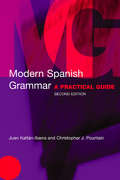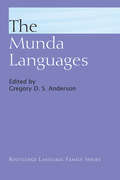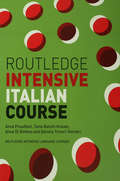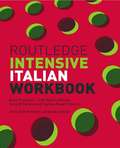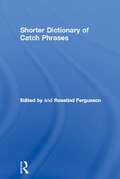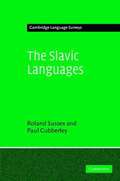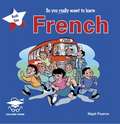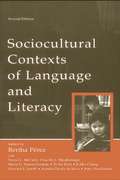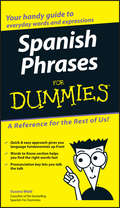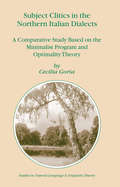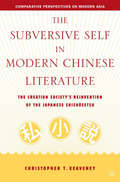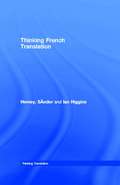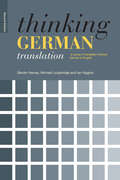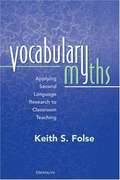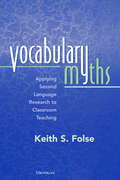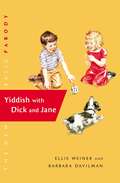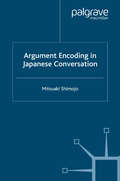- Table View
- List View
Modern Spanish Grammar: A Practical Guide
by Christopher Pountain Juan Kattan-Ibarra Juan Kattán-IbarraModern Spanish Grammar: A Practical Guide is an innovative reference guide to Spanish, combining traditional and function-based grammar in a single volume.The Grammar is divided into two parts. The shorter section covers traditional grammatical categories such as word order, nouns, verbs and adjectives. The larger section is carefully organized around language functions and notions such as: giving and seeking information putting actions into context* expressing likes, dislikes and preferences comparing objects and actions.All grammar points and functions are richly illustrated and information is provided on register and relevant cultural background. Written by experienced teachers and academics, the Grammar has a strong emphasis on contemporary usage. Particular attention is paid to indexing and cross-referencing across the two sections. This is the ideal reference grammar for learners of Spanish at all levels, from elementary to advanced. It will prove invaluable to those with little experience of formal grammar, as no prior knowledge of grammatical terminology is assumed and a glossary of terms is provided. The book will also be useful to teachers seeking back-up to functional syllabuses, and to designers of Spanish courses.
Modern Spanish Grammar: A Practical Guide
by Christopher Pountain Juan Kattan-Ibarra Juan Kattán-IbarraModern Spanish Grammar: A Practical Guide is an innovative reference guide to Spanish, combining traditional and function-based grammar in a single volume.The Grammar is divided into two parts. The shorter section covers traditional grammatical categories such as word order, nouns, verbs and adjectives. The larger section is carefully organized around language functions and notions such as: giving and seeking information putting actions into context* expressing likes, dislikes and preferences comparing objects and actions.All grammar points and functions are richly illustrated and information is provided on register and relevant cultural background. Written by experienced teachers and academics, the Grammar has a strong emphasis on contemporary usage. Particular attention is paid to indexing and cross-referencing across the two sections. This is the ideal reference grammar for learners of Spanish at all levels, from elementary to advanced. It will prove invaluable to those with little experience of formal grammar, as no prior knowledge of grammatical terminology is assumed and a glossary of terms is provided. The book will also be useful to teachers seeking back-up to functional syllabuses, and to designers of Spanish courses.
The Munda Languages (Routledge Language Family Series)
by Gregory D.S. AndersonThe Munda group of languages of the Austroasiatic family are spoken within central and eastern India by almost ten million people. To date, they are the least well-known and least documented languages of the Indian subcontinent. This unprecedented and original work draws together a distinguished group of international experts in the field of Munda language research and presents current assessments of a wide range of typological and comparative-historical issues, providing agendas for future research. Representing the current state of Munda Linguistics, this volume provides detailed descriptions of almost all of the languages in the family, in addition to a brief chapter discussing the enigmatic Nihali language.
The Munda Languages (Routledge Language Family Series)
by Gregory D.S. AndersonThe Munda group of languages of the Austroasiatic family are spoken within central and eastern India by almost ten million people. To date, they are the least well-known and least documented languages of the Indian subcontinent. This unprecedented and original work draws together a distinguished group of international experts in the field of Munda language research and presents current assessments of a wide range of typological and comparative-historical issues, providing agendas for future research. Representing the current state of Munda Linguistics, this volume provides detailed descriptions of almost all of the languages in the family, in addition to a brief chapter discussing the enigmatic Nihali language.
Routledge Intensive Italian Course
by Anna Proudfoot Tania Batelli Kneale Daniela Treveri Gennari Anna Di StefanoThis intensive foundation course in Italian is designed for students with no previous knowledge of the language. Accompanying audio material containing dialogues, listening exercises and pronunciation practice is available to purchase separately in CD format. These two audio CDs are designed to work alongside the accompanying book. Students using the Routledge Intensive Italian Course will practise the four key skills of language learning - reading, writing, speaking, and listening - and will acquire a thorough working knowledge of the structures of Italian. The Routledge Intensive Italian Course takes students from beginner to intermediate level in one year.
Routledge Intensive Italian Course
by Anna Proudfoot Tania Batelli Kneale Daniela Treveri Gennari Anna Di StefanoThis intensive foundation course in Italian is designed for students with no previous knowledge of the language. Accompanying audio material containing dialogues, listening exercises and pronunciation practice is available to purchase separately in CD format. These two audio CDs are designed to work alongside the accompanying book. Students using the Routledge Intensive Italian Course will practise the four key skills of language learning - reading, writing, speaking, and listening - and will acquire a thorough working knowledge of the structures of Italian. The Routledge Intensive Italian Course takes students from beginner to intermediate level in one year.
Routledge Intensive Italian Workbook
by Anna Proudfoot Tania Batelli Kneale Anna Di Stefano Daniela Treveri GennariThe Routledge Intensive Italian Workbook is a comprehensive book of exercises and tasks for beginner and intermediate learners of Italian.It includes a wide variety of exercises - covering a broad range of situations and functions - and will help students to progress rapidly and master the language accurately. Students can check their own progress using the answer key. The Workbook can be used independently, or in conjunction with the Routledge Intensive Italian Course, an accelerated course in Italian for adult beginners, which is accompanied by audio material.
Routledge Intensive Italian Workbook
by Anna Proudfoot Tania Batelli Kneale Anna Di Stefano Daniela Treveri GennariThe Routledge Intensive Italian Workbook is a comprehensive book of exercises and tasks for beginner and intermediate learners of Italian.It includes a wide variety of exercises - covering a broad range of situations and functions - and will help students to progress rapidly and master the language accurately. Students can check their own progress using the answer key. The Workbook can be used independently, or in conjunction with the Routledge Intensive Italian Course, an accelerated course in Italian for adult beginners, which is accompanied by audio material.
Shorter Dictionary of Catch Phrases
by Rosalind FergussonThis collection will appeal to everyone who has ever wondered about the origin of phrases like "all part of life's rich pattern" and "long time no see". It covers a wide range of catch phrases in current use in all parts of the English-speaking world. Most entries are drawn from the second edition of Eric Partridge's Dictionary of Catch Phrases (second edition, edited by Paul Beale), but have been completely rewritten in the light of recent research, and there are many additions. Catch Phrases include: close your eyes and think of England! have I got news for you! ... refreshes the parts that other ... cannot reach some mothers do'ave'em! you are awful, but I like you.
Shorter Dictionary of Catch Phrases: From The Work Of Eric Partridge And Paul Beale
by Rosalind FergussonThis collection will appeal to everyone who has ever wondered about the origin of phrases like "all part of life's rich pattern" and "long time no see". It covers a wide range of catch phrases in current use in all parts of the English-speaking world. Most entries are drawn from the second edition of Eric Partridge's Dictionary of Catch Phrases (second edition, edited by Paul Beale), but have been completely rewritten in the light of recent research, and there are many additions. Catch Phrases include: close your eyes and think of England! have I got news for you! ... refreshes the parts that other ... cannot reach some mothers do'ave'em! you are awful, but I like you.
The Slavic Languages (PDF)
by Roland Sussex Paul CubberleyThe Slavic group of languages - the fourth largest Indo-European sub-group - is one of the major language families of the modern world. With 297 million speakers, Slavic comprises 13 languages split into three groups: South Slavic, which includes Bosnian, Serbian and Croatian; East Slavic, which includes Russian and Ukrainian; and West Slavic, which includes Polish, Czech and Slovak. This 2006 book, written by two leading scholars in Slavic linguistics, presents a survey of all aspects of the linguistic structure of the Slavic languages, considering in particular those languages that enjoy official status. As well as covering the central issues of phonology, morphology, syntax, word-formation, lexicology and typology, the authors discuss Slavic dialects, sociolinguistic issues, and the socio-historical evolution of the Slavic languages. Accessibly written and comprehensive in its coverage, this book will be welcomed by scholars and students of Slavic languages, as well as linguists across the many branches of the discipline.
So You Really Want to Learn French Book 1 (PDF)
by Nigel PearceA clear and simple introduction to learning a language.This first French book takes a no-nonsense approach to the elementary stages of French with clear, grammatical explanations and challenging exercises.nbsp;
Sociocultural Contexts of Language and Literacy
by Teresa L. McCarty Lucille J. Watahomigie To Thi Dien Bertha Perez Mar¡a E. Torres-GuzmanSociocultural Contexts of Language and Literacy, Second Edition engages prospective and in-service teachers in learning about linguistically and culturally diverse students, and in using this knowledge to enrich literacy learning in classrooms and communities. The text is grounded in current research and theory that integrate sociocultural and constructivist concepts and perspectives and provide a framework teachers can use to develop strategies for teaching reading, writing, and thinking to diverse students. The focus on English literacy development does not imply advocacy for "English only" or ESL as the primary mode of literacy instruction. Rather, the authors take the position that learners need to develop literacy in their native language and that the concepts and skills learned in developing the native language create a foundation of strength from which students can develop English literacy. Part I introduces relevant research and language learning theories. Part II provides research reviews and information about literacy learning within specific culturally and linguistically diverse communities. The chapters in Part III challenge the reader to view the multiple social, intellectual, cultural, and language differences children bring to the classroom as an opportunity for learning and building on the diversity among students. Activities and suggested readings at the end of each chapter involve readers in reflection, observation, meaning making, and the construction of application processes for their new understandings. New in the Second Edition:*updated research and theory on multilingual and second language literacy;*a focus on the interpretation of these research findings to make them useful for teachers and teacher educators in understanding and articulating the research bases for literacy practices; *attention to current intensely debated issues, such as standards, the phonics movement, and high-stakes testing; and*new activities and suggested readings.
Sociocultural Contexts of Language and Literacy
by Teresa L. McCarty Lucille J. Watahomigie To Thi Dien Bertha Perez Mar¡a E. Torres-GuzmanSociocultural Contexts of Language and Literacy, Second Edition engages prospective and in-service teachers in learning about linguistically and culturally diverse students, and in using this knowledge to enrich literacy learning in classrooms and communities. The text is grounded in current research and theory that integrate sociocultural and constructivist concepts and perspectives and provide a framework teachers can use to develop strategies for teaching reading, writing, and thinking to diverse students. The focus on English literacy development does not imply advocacy for "English only" or ESL as the primary mode of literacy instruction. Rather, the authors take the position that learners need to develop literacy in their native language and that the concepts and skills learned in developing the native language create a foundation of strength from which students can develop English literacy. Part I introduces relevant research and language learning theories. Part II provides research reviews and information about literacy learning within specific culturally and linguistically diverse communities. The chapters in Part III challenge the reader to view the multiple social, intellectual, cultural, and language differences children bring to the classroom as an opportunity for learning and building on the diversity among students. Activities and suggested readings at the end of each chapter involve readers in reflection, observation, meaning making, and the construction of application processes for their new understandings. New in the Second Edition:*updated research and theory on multilingual and second language literacy;*a focus on the interpretation of these research findings to make them useful for teachers and teacher educators in understanding and articulating the research bases for literacy practices; *attention to current intensely debated issues, such as standards, the phonics movement, and high-stakes testing; and*new activities and suggested readings.
Spanish Phrases For Dummies
by Susana WaldThe fun and easy way to speak Spanish With Mexico the #1 international destination for Americans, over 14 million secondary school students enrolled in Spanish classes, and Spanish the primary language in many neighborhoods from L.A. to Miami, this should easily be the most popular title in our new phrase book series, following in the footsteps of Spanish For Dummies (0-7645-5194-9), which has sold more than 300,000 copies. Susana Wald is a writer, teacher, and translator.
Subject Clitics in the Northern Italian Dialects: A Comparative Study Based on the Minimalist Program and Optimality Theory (Studies in Natural Language and Linguistic Theory #60)
by Cecilia Goria1. 0 INTRODUCTION This book provides an encompassing analysis of Subject Clitics (SCLs) by giving a detailed description of these elements in two varieties of Piedmontese, a Northern Italian Dialect: Astigiano and Turinese spoken in the areas of Asti and Turin respectively. It accounts for the structural position and function of these elements inside the computational system and for their morphological and distributional properties. It also provides an empirical and theoretical comparison between Piedmontese SCLs and SCLs in other Northern Italian Dialects (NIDs). of SCLs types in the NIDs have been regarded as Since the 1980s, the majority elements of agreement, in that they contribute to the realisation of subject verb agreement by expressing features of the subject similar, in a way, to verbal inflection. Nonetheless, SCLs are not to be assimilated to verbal affixes as they exhibit different properties. Most distinctively, they can be separated from the verb by other clitic elements and, in the case of the varieties considered here, SCLs are optional in all contexts and may be omitted in coordination. A more refined identification of SCLs separates SCLs which encode agreement features from those which do not and are related to pragmatic factors, as originally observed by Beninca (1994) with respect to the clitic a in Paduano The different morphological and syntactic properties that characterise SCLs across the NIDs have justified numerous accounts which regard them as head of their own projection.
The Subversive Self in Modern Chinese Literature: The Creation Society’s Reinvention of the Japanese Shishôsetsu (Comparative Perspectives on Modern Asia)
by C. KeaveneyAn examination of whether Chinese writers of the Creation Society, a Chinese literary coterie, successfully appropriated shishosetsu, a quintessentially Japanese form of autobiographical narrative, into a form to be exploited for their own ends, especially political ends.
Thinking French Translation: A Course In Translation Method-french To English (Thinking Translation)
by Sándor Hervey Ian HigginsThe new edition of this popular course in translation from French into English offers a challenging practical approach to the acquisition of translation skills, with clear explanations of the theoretical issues involved. A variety of translation issues are considered including:*cultural differences*register and dialect*genre*revision and editing.The course now covers texts from a wide range of sources, including:*journalism and literature*commercial, legal and technical texts*songs and recorded interviews.This is essential reading for advanced undergraduates and postgraduate students of French on translation courses. The book will also appeal to wide range of language students and tutors.
Thinking French Translation (Thinking Translation)
by Sándor Hervey Ian HigginsThe new edition of this popular course in translation from French into English offers a challenging practical approach to the acquisition of translation skills, with clear explanations of the theoretical issues involved. A variety of translation issues are considered including:*cultural differences*register and dialect*genre*revision and editing.The course now covers texts from a wide range of sources, including:*journalism and literature*commercial, legal and technical texts*songs and recorded interviews.This is essential reading for advanced undergraduates and postgraduate students of French on translation courses. The book will also appeal to wide range of language students and tutors.
Thinking German Translation (Thinking Translation)
by Ian Higgins Sandor Hervey Michael LoughridgeThis is a comprehensive practical course in translation for advanced students of German, which focuses on improving translation quality whilst clarifying the theoretical issues involved. This second edition brings the course up-to-date, and has been fully reworked to give clearer explanations of key terms and include revised chapters on genre, compensation and revision and editing. Based on detailed analysis of translation problems, Thinking German Translation features new material taken from a wide range of sources, including: business and politics press and publicity engineering tourism literary and consumer-oriented texts. Addressing a variety of translation issues such as cultural difference, register and dialect, Thinking German Translation is essential reading for all students wishing to perfect their translation skills. It is also an excellent foundation for those considering a career in translation. Further resources, including a free teacher's handbook for the course, are available on the companion website at http://cw.routledge.com/textbooks/0415341469/resources/default.asp
Thinking German Translation: A Course In Translation Method: German To English (Thinking Translation)
by Ian Higgins Sandor Hervey Michael LoughridgeThis is a comprehensive practical course in translation for advanced students of German, which focuses on improving translation quality whilst clarifying the theoretical issues involved. This second edition brings the course up-to-date, and has been fully reworked to give clearer explanations of key terms and include revised chapters on genre, compensation and revision and editing. Based on detailed analysis of translation problems, Thinking German Translation features new material taken from a wide range of sources, including: business and politics press and publicity engineering tourism literary and consumer-oriented texts. Addressing a variety of translation issues such as cultural difference, register and dialect, Thinking German Translation is essential reading for all students wishing to perfect their translation skills. It is also an excellent foundation for those considering a career in translation. Further resources, including a free teacher's handbook for the course, are available on the companion website at http://cw.routledge.com/textbooks/0415341469/resources/default.asp
Vocabulary Myths: Applying Second Language Research to Classroom Teaching (PDF)
by Keith S. FolseIn Vocabulary Myths, Keith S. Folse breaks down the teaching of second language vocabulary into eight commonly held myths. In debunking each myth, he introduces the myth with a story based on his 25 years of teaching experience (in the United States and abroad), continues with a presentation of what empirical research has shown on the topic, and finishes with a list of what teachers can do in their classrooms to facilitate true vocabulary acquisition. The goal of Vocabulary Myths is to foster a paradigm shift that correctly views vocabulary as fundamental in any second language learning process and demonstrates that research supports this goal-that in fact there is a wealth of empirical evidence to support these views. In addition, an important theme is that teachers have overestimated how much vocabulary students really understand, and as a result, the so-called "comprehensible input" is neither comprehensible nor input. The second language vocabulary acquisition myths reexamined in this book are: *In learning another language, vocabulary is not as important as grammar or other areas. *Using word lists to learn L2 vocabulary is unproductive. *Presenting new vocabulary in semantic sets facilitates learning. *The use of translations to learn new vocabulary should be discouraged. *Guessing words from context is an excellent strategy for learning L2 vocabulary. *The best vocabulary learners make use of one or two really specific vocabulary learning strategies. *The best dictionary for L2 learners is a monolingual dictionary. *Teachers, textbooks, and curricula cover L2 vocabulary adequately.
Vocabulary Myths: Applying Second Language Research to Classroom Teaching
by Keith S. FolseIn Vocabulary Myths, Keith S. Folse breaks down the teaching of second language vocabulary into eight commonly held myths. In debunking each myth, he introduces the myth with a story based on his 25 years of teaching experience (in the United States and abroad), continues with a presentation of what empirical research has shown on the topic, and finishes with a list of what teachers can do in their classrooms to facilitate true vocabulary acquisition. The goal of Vocabulary Myths is to foster a paradigm shift that correctly views vocabulary as fundamental in any second language learning process and demonstrates that research supports this goal-that in fact there is a wealth of empirical evidence to support these views. In addition, an important theme is that teachers have overestimated how much vocabulary students really understand, and as a result, the so-called "comprehensible input" is neither comprehensible nor input. The second language vocabulary acquisition myths reexamined in this book are: *In learning another language, vocabulary is not as important as grammar or other areas. *Using word lists to learn L2 vocabulary is unproductive. *Presenting new vocabulary in semantic sets facilitates learning. *The use of translations to learn new vocabulary should be discouraged. *Guessing words from context is an excellent strategy for learning L2 vocabulary. *The best vocabulary learners make use of one or two really specific vocabulary learning strategies. *The best dictionary for L2 learners is a monolingual dictionary. *Teachers, textbooks, and curricula cover L2 vocabulary adequately.
Yiddish with Dick and Jane
by Ellis Weiner Barbara DavilmanJane is in real estate. Today is Saturday. Jane has an open house. She must schlep the Open House signs to the car. See Jane schlep. Schlep, Jane. Schlep. Schlep, schlep, schlep. In text that captures the unque rhythms of the original Dick and Jane readers, and in 35 all-new illustrations, a story unfolds in which Dick and Jane -- hero and heroine of the classic books for children that generations of Americans have used when learning to read -- manage to express shades of feeling and nuances of meaning that ordinary English just can't deliver. How? By speaking Yiddish, employing terms that convey an attitude -- part plucky self-assertion, part ironic fatalism. When Dick schmoozes, when Jane kvetches, when their children fress noodles at a Chinese restaurant, the clash of cultures produces genuine hilarity.
Argument Encoding in Japanese Conversation
by M. ShimojoJapanese is well known for its array of argument encoding types - but how is speakers' choice of encoding types to be described? This book investigates the encoding of subject and direct object in conversational Japanese and attempts to explain Japanese argument encoding as a unified system. Qualitative and quantitative analyses of a bank of conversation are provided, with the emphasis on speakers' use of the encoding types rather than their acceptability for given arguments.
